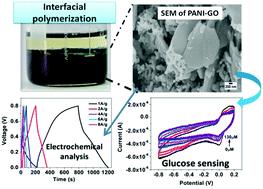当前位置:
X-MOL 学术
›
New J. Chem.
›
论文详情
Our official English website, www.x-mol.net, welcomes your feedback! (Note: you will need to create a separate account there.)
Fabrication of polyaniline–graphene oxide hybrid nanocomposites by green interfacial polymerization for all-solid-state supercapacitors and enzymatic glucose sensors
New Journal of Chemistry ( IF 3.3 ) Pub Date : 2021-08-16 , DOI: 10.1039/d1nj01741a Gayatri Konwar 1 , Jumi Deka 2 , Kalyan Raidongia 2 , Debajyoti Mahanta 1
New Journal of Chemistry ( IF 3.3 ) Pub Date : 2021-08-16 , DOI: 10.1039/d1nj01741a Gayatri Konwar 1 , Jumi Deka 2 , Kalyan Raidongia 2 , Debajyoti Mahanta 1
Affiliation

|
An interfacial polymerization-based green approach was developed for the synthesis of polyaniline–graphene oxide (PANI-GO) nanocomposites. Instead of the commonly used organic solvents such as CHCl3, CCl4, hexane and toluene, vegetable oil was used here as the organic phase. Thus, the prepared nanocomposite was characterized by Fourier-transform infrared spectroscopy (FTIR), UV-visible spectroscopy, powder X-ray diffraction (PXRD), and thermogravimetric analysis (TGA) techniques. The scanning electron microscopy (SEM) examinations revealed the formation of a uniform coating of PANI fibers on the surface of GO sheets. The PANI-GO composite showed pseudocapacitive behavior with a high specific capacitance of 510 F g−1 at a current density of 1 A g−1. The specific energy and specific power of the PANI-GO electrode material were calculated to be 45.3 W h kg−1 and 407.9 W kg−1, respectively, which maintained 92% stability even after completing 1000 cycles at a current density of 30 A g−1. Furthermore, the solid-state symmetric supercapacitor of the PANI-GO nanocomposite yielded an areal capacitance of 143.6 mF cm−2 at a current density of 1 mA cm−2. The symmetric supercapacitor maintains 76% of its initial areal capacitance after 4000 cycles. The PANI-GO nanocomposite was also explored for the fabrication of enzymatic glucose sensors. The amperometric response of PANI-GO indicates that the enzyme-loaded electrode material exhibited good catalytic activity towards the oxidation of glucose in the linear range of 20–80 μM. The limit of detection was found to be 12 μM with a signal-to-noise ratio of 3 (S/N = 3).
中文翻译:

通过绿色界面聚合制备用于全固态超级电容器和酶促葡萄糖传感器的聚苯胺-氧化石墨烯杂化纳米复合材料
开发了一种基于界面聚合的绿色方法来合成聚苯胺-氧化石墨烯(PANI-GO)纳米复合材料。代替常用的有机溶剂如 CHCl 3、CCl 4、己烷和甲苯,这里使用植物油作为有机相。因此,制备的纳米复合材料通过傅里叶变换红外光谱 (FTIR)、紫外-可见光谱、粉末 X 射线衍射 (PXRD) 和热重分析 (TGA) 技术进行表征。扫描电子显微镜 (SEM) 检查显示在 GO 片材表面形成了均匀的 PANI 纤维涂层。PANI-GO 复合材料表现出赝电容行为,在 1 A g 的电流密度下具有 510 F g -1的高比电容-1。PANI-GO电极材料的比能量和比功率分别计算为45.3 W h kg -1和407.9 W kg -1,即使在30 A g的电流密度下完成1000次循环后仍保持92%的稳定性-1。此外,PANI-GO 纳米复合材料的固态对称超级电容器在 1 mA cm -2的电流密度下产生了 143.6 mF cm -2的面积电容. 对称超级电容器在 4000 次循环后仍保持其初始面积电容的 76%。还探索了 PANI-GO 纳米复合材料用于制造酶促葡萄糖传感器。PANI-GO 的电流响应表明载酶电极材料在 20-80 μM 的线性范围内对葡萄糖的氧化表现出良好的催化活性。发现检测限为 12 μM,信噪比为 3 (S/N = 3)。
更新日期:2021-09-09
中文翻译:

通过绿色界面聚合制备用于全固态超级电容器和酶促葡萄糖传感器的聚苯胺-氧化石墨烯杂化纳米复合材料
开发了一种基于界面聚合的绿色方法来合成聚苯胺-氧化石墨烯(PANI-GO)纳米复合材料。代替常用的有机溶剂如 CHCl 3、CCl 4、己烷和甲苯,这里使用植物油作为有机相。因此,制备的纳米复合材料通过傅里叶变换红外光谱 (FTIR)、紫外-可见光谱、粉末 X 射线衍射 (PXRD) 和热重分析 (TGA) 技术进行表征。扫描电子显微镜 (SEM) 检查显示在 GO 片材表面形成了均匀的 PANI 纤维涂层。PANI-GO 复合材料表现出赝电容行为,在 1 A g 的电流密度下具有 510 F g -1的高比电容-1。PANI-GO电极材料的比能量和比功率分别计算为45.3 W h kg -1和407.9 W kg -1,即使在30 A g的电流密度下完成1000次循环后仍保持92%的稳定性-1。此外,PANI-GO 纳米复合材料的固态对称超级电容器在 1 mA cm -2的电流密度下产生了 143.6 mF cm -2的面积电容. 对称超级电容器在 4000 次循环后仍保持其初始面积电容的 76%。还探索了 PANI-GO 纳米复合材料用于制造酶促葡萄糖传感器。PANI-GO 的电流响应表明载酶电极材料在 20-80 μM 的线性范围内对葡萄糖的氧化表现出良好的催化活性。发现检测限为 12 μM,信噪比为 3 (S/N = 3)。


























 京公网安备 11010802027423号
京公网安备 11010802027423号